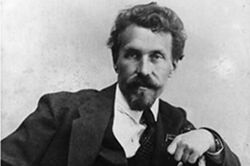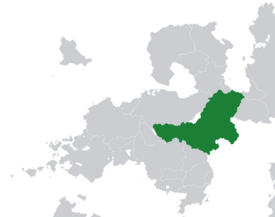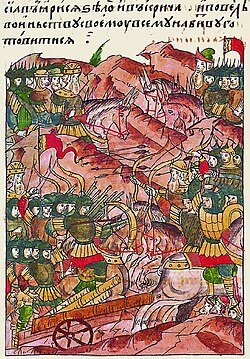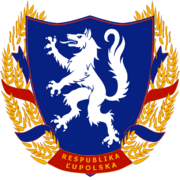Luepola
This article is incomplete because it is pending further input from participants, or it is a work-in-progress by one author. Please comment on this article's talk page to share your input, comments and questions. Note: To contribute to this article, you may need to seek help from the author(s) of this page. |
Republic of Luepola Respublika Ľupolska | |
|---|---|
| Motto: Narod i Sloboda Naviek Nation and Freedom Forever | |
| Anthem: Marš Pobiede Victory March | |
Location of Luepola | |
| Capital | Prishek |
| Largest city | Voitz |
| Official languages | Luepolan |
| Recognised regional languages | |
| Ethnic groups (2018) | Luepolan Molves 82% Non-Luepolan Molves 12% Njataris 3% Vierz 2% Other 1% |
| Religion | Orthodoxy |
| Demonym(s) | Luepolan |
| Government | Federal semi-presidential republic |
• President | Savo Grigorević |
• Vice President | Anastasi Obrádović |
• Prime Minister | Radovan Kozić |
| Legislature | Sliet |
| Great Assembly Veliki Sbor | |
| Popular Assembly Ľudovi Sbor | |
| Establishment | |
• Unification of Varadna and Strentland | 4 August 1329 |
| 10 July 1390 | |
| 13 March 1979 | |
• Establishment of the Modern Republic | 1 January 1980 |
| 8 July 1985 | |
| Area | |
• Total | 760,140 km2 (293,490 sq mi) |
| Population | |
• 2019 estimate | 79,295,273 |
• Density | 104.32/km2 (270.2/sq mi) |
| GDP (PPP) | 2019 estimate |
• Total | $2,185,348,873,474 (2.1 trillion) |
• Per capita | $27,521 |
| GDP (nominal) | 2019 estimate |
• Total | $1,798,559,354,100 (1.8 trillion) |
• Per capita | $22,650 |
| Gini | 29.1 low |
| HDI | 0.845 very high |
| Currency | Luepolan Grivna (Ғ) (LG) |
| Time zone | UTC+2 |
| Date format | dd.mm.yyyy |
| Driving side | right |
| Calling code | +52 |
| Internet TLD | .lu |
Luepola (/luˈpoʊlə/, Luepolan: Ľupola [ʎuˈpɔla]), officially the Republic of Luepola (Respublika Ľupolska [resˈpublika ʎuˈpɔlska]), is a federal parliamentary republic located in eastern Patyria. It is divided into fourteen voblasts and two federal municipalities. Luepola covers a total of 760,140 square kilometers, making it the largest nation in Patyria, and has a population of 79,295,273, making it the second most populous nation in Patyria after Vierzland. Luepola's capital is Prishek, and its largest city is Voitz. Other notable Luepolan cities include Rostva, Pomorna, Hrdovna, Zvin, Grast, and Utrna. Luepola is bordered to the north by Vyzinia, Plosenia, and the Gulf of St. Jan; to the east by Tanavia, Vorochia, and the Oriental Sea; to the south by Zacotia and Granzery; and to the west by Lairea and Vierzland.
Luepola's territory was inhabited by numerous people groups, including Ardes, Veisics, and Morvones. The Molves had migrated into the region by the 1st century BC, and largely dominated the coastal regions by 400 AD, though frequently were subject to military campaigns by the Deoran Empire. Molvic tribes constituted a significant portion of Megenfrit's army which sacked Deora and brought about the collapse of the Deoran Empire. Among these Molvic tribes were the Bosani and Varadii, who eventually settled in the regions of Trnava and Varadna and evolved into the kingdoms of Varadna and Strentland. Explorers employed by Strentland in 1240 charted a direct naval route to Mahsadar, establishing a regular trade between Patyria and Oridia that Strentland could significantly profit from and laying the groundwork for Luepola's future prosperity.
Luepola was first unified by Genadi the Great, king of Strentland, and Vladislava I, queen of Varadna, as an expansion of the personal union between the two kingdoms. Facing war from its founding, the Kingdom of Luepola defeated Plosenia, Zacotia, and various Grozyar tribes in successive wars and vastly expanded its territory to control most of the East Patyrian Plain, before being contained by Granzery and the Vierz League. Having annexed coastline on the Gulf of St. Jan, Luepola was able to control nearly all trade that passed from Patyria to Oridia, save for naval traffic through Cestros. The Kingdom of Luepola would struggle against Cestros for much of the Middle Ages for control over the Oriental Sea, and for political dominance of the Eastern Wedian world. This rivalry was punctuated by periods of partnership, such as during the East Patyrian War.
The Kingdom of Luepola began to face stagnation as the discovery of the Artalias enabled western Patyrian states to acquire vast swathes of new territory and resources, and to end their reliance on Luepola and Cestros for trade with the east. Largely unable to challenge new powerhouses in Patyria such as the Vierz Empire and Apelia, the Luepolan kingdom entered a period of isolationist politics. A series of inefficient emperors and humiliations at the hands of attacking foreign powers inflamed nationalist and republican sentiments within the country. Influenced by the concurrent expansion of Tierada by Antonio de Caberra, Luepolan citizens overthrew King Ratimir II in the Luepolan Revolution of 1818, ending nearly 900 years of monarchial rule over Luepola. Igor Petrušić, the inaugural president of the Republic of Luepola, initially allied with de Caberra before helping the Vierz Empire's Coalition defeat Tierada, thereby legitimizing Luepola's republican rule among the royals and nobles of the rest of the continent. Luepola would grow to become a haven of liberal ideals in the 19th century, and largely evaded the turmoil of the Patyrian Revolutions of the 19th century as a result. As the powers of Patyria colonized Oridia and Tusola, Luepola established its own overseas colonial empire, primarily in West Oridia.
By the 1890s, Luepola fell under the sway of Flecquist rhetoric, resulting in the rise to power of Lev Gincburg and the Communist Party of Luepola in 1901 and the transformation of the country into a one-party socialist state. Through Luepolan state institutions, the Communist party under Stanislav Kolar and Anton Marusić inspired and aided movements across the continent, particularly in Vierzland, Granzery, and Apelia, as well as in Poicary. The latter countries eventually installed their own socialist governments, galvanizing into the Socialist International Coalition. Luepola's attempt to impose socialism on Zacotia by force ignited the Great War, which saw the defeat of the SIC by the Allianz led by Tierada, Vierzland and Vonzumier. Following its defeat, Luepola was military occupied by Vierzland and its government reformed into an authoritarian state within the Vierz sphere of influence, which persisted for much of the Silent War. The decades-long suppression of Luepolan nationalism culminated in the Luepolan Spring, in which the Luepolan government was overthrown and its replacement government, led by Emil Ivanušić, outlasted a Vierz invasion of the country.
Luepola is considered by most to be a great power. Luepola commands the world's eighth largest economy by GDP; since 2000, it has also ranked among the highest in the world for education and political freedom. Luepolan cultural influence is prominent in Mahsadar and other West Oridian countries such as Njataristan and Sirad, owing to its legacy as a colonial power. Luepola is a full member of the International Assembly and Leisau Group. Luepola maintains the second largest military in Patyria by active personnel; Luepola is also considered a nuclear threshold state.
History
Prehistory
Molvic Tribal Era
Kingdoms of Varadna and Strentland
Unification of Varadna and Strentland; Kingdom of Luepola (1329-1818)
The Kingdom of Luepola, then known as Varadna-Strentland, was established in 1329 by Genadi I of Strentland. Genadi's wife Vladislava I was the heir apparent to the throne of Varadna; upon her coronation, their son became the heir to both thrones, and Vladislava opted to instead cede control of Varadna to Genadi, unifying the two countries ahead of schedule.
A period of turmoil followed, as the newly unified country was torn into civil war by the two separate houses of nobility backing different successors following the death of Genadi the Lesser. Princess Cvieta I, the preferred heir by the Varadian nobility, emerged victorious from the war. Shortly after the end of the war, neighboring kingdoms Plosenia and Zacotia invaded Varadna-Strentland, initiating the Containment Wars, in which Varadna-Strentland allied Vyzinia to retake its territory and eventually partition Plosenia and annex significant parts of Zacotia. The victory was followed by the declaration of the Kingdom of Luepola as the successor to Varadna-Strentland.
First Luepolan Republic (1818-1905)
People's Republic of Luepola (1905-1948)

The People's Republic of Luepola was officially declared by Lev Gincburg after likely illegitimately winning his re-election as the President of Luepola. The declaration was followed by the relatively quick and violent transformation of Luepola into a one-party socialist state. The Communist Party used its stranglehold over the country to eliminate political opponents and dissidents, hasten Luepola's relatively slow industrialization, reform the Luepolan language and script, and export its ideology to other nations. Countries such as Vorochia, Granzery, Poicary and Apelia fell sway to communism throughout the first half of the 20th century. Luepola transformed its colonial holdings in Oridia and Tusola into socialist republics, but effectively maintained a stranglehold on their state affairs.
On 8 April 1942, invasion of Zacotia in order to install a Communist government. Vierzland and Savland each declared war on Luepola in turn, beginning the Great War. After a poorly-prepared Vierz invasion of Luepola failed, Luepola went on the offensive, bringing Apelia and Granzery into the war as members of the Socialist International Coalition and besieging Vierzland on all of its land borders while also invading southern Patyria, annexing the region alongside Granzery and similarly laying siege to Cestros. Intermittent Coalition air raids on Vierzland escalated into full-scale strategic and terror bombing campaigns which were later reciprocated by the Allied nations; one of the most notable such air raids was the Bombing of Talheim, in which the use of chemical weapons killed tens of thousands in the deadliest week of the war. Shortly after, the Luepolans initiated the Battle of Kasenberg, the largest single battle of the war. Nonetheless, Luepola's efforts at overrunning Vierzland's and Cestros's defensive lines were unsuccessful, and the entry of Vonzumier into the war placed increased pressure on Luepola's southern front and forcing her to defend her colonial holdings. Decisive defeats inflicted on Luepola at Kasenberg, Tarphos, and the Verakoni Gap forced Luepola on the defensive, but Luepola was nonetheless able to maintain its own defensive line close within its pre-war borders until fall 1947, when the Allied Operation Rapture forced Apelia's surrender. In the final six months of the war, Luepola found itself overwhelmed as Vonzumier and Vierzland mounted a final offensive against Luepola. After the death of Marusić, acting Chairman Saňin Mlakar ordered the surreder of Luepola to the Vierz army, effectively ending the war. The Treaty of Adtrus would later dissolve the Luepolan communist government, place Luepola's satellite republics in Oridia under Vierz administration, and subject Luepola to military occupation by Vierzland.
Vierz Occupation and the State of Luepola (1948-1977)
Luepolan Spring (1977-1985)
Second Republic of Luepola (1985-Present)
Geography

Climate
Biodiversity
Demographics
Population
Ethnic Groups
Languages
Religion
Health
Education
Urbanization
| Largest cities of Luepola (2019 census) | |||||||||
|---|---|---|---|---|---|---|---|---|---|
| City | Population | State | City | Population | State | ||||
| 1 | Voitz | 2,364,964 | Občina Vojc | 11 | Bráznica | 595,788 | Aneska | ||
| 2 | Rostva | 1,512,376 | Jutska | 12 | Elenevo | 581,393 | Jutska | ||
| 3 | Prishek | 948,083 | Hautbecirk | 13 | Čakajec | 560,848 | Bružka | ||
| 4 | Zvin | 713,555 | Varadna | 14 | Aneska | 557,854 | Aneska | ||
| 5 | Grast | 704,721 | Trnava | 15 | Voľana | 547,967 | Varadna | ||
| 6 | Kořevac | 687,397 | Trnava | 16 | Nediňe | 539,901 | Bosunija | ||
| 7 | Bosaňe | 664,919 | Dvolăn | 17 | Mlaževo | 500,608 | Varadna | ||
| 8 | Hrdovna | 655,083 | Sevierna | 18 | Đalan | 488,226 | Nimorăn | ||
| 9 | Utrna | 644,323 | Bosunija | 19 | Judusa | 472,475 | Bosunija | ||
| 10 | Pomorna | 638,575 | Jutska | 20 | Obránse | 470,273 | Cărnipoře | ||
Politics
Constitution of Luepola
Government and the Sliet
Law Enforcement
Foreign Relations
Armed Forces
Culture
Art
Literature
Music
Television and Cinema
Sport
Cuisine








